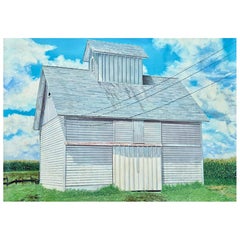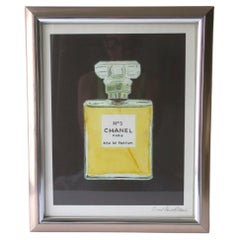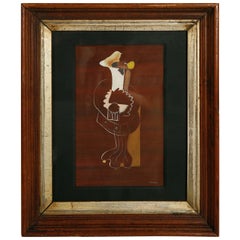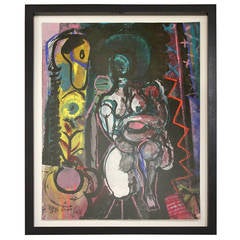Harold Gregor Paintings
to
1
1
Height
to
Width
to
1
1
1
1
1
1
1
1
1
1
1
103
80
49
46
Creator: Harold Gregor
Harold Gregor Original Painting Illinois Corn Crib No. 23
By Harold Gregor
Located in West Hartford, CT
A striking, large-scale painting from Gregor’s celebrated Corn Crib series, depicting a classic Midwestern rural landscape in photorealistic detail. Gregor i...
Category
1970s American Vintage Harold Gregor Paintings
Materials
Canvas
Related Items
Watercolor Painting Chanel No. 5 Perfume
Located in New York, NY
A beautiful watercolor painting of the iconic Chanel No. 5 perfume bottle, signed by artist, 2012, New York, USA. A beautiful and well-done watercolor painting of the iconic Chanel N...
Category
2010s American Modern Harold Gregor Paintings
Materials
Metal
Abstract Painting in Original Frame
Located in Palm Desert, CA
A fun abstract painting on a merlot background in its original walnut & gilt frame with antique glass. We have not been able to find any information on the artist, but it is signed a...
Category
Early 20th Century American Harold Gregor Paintings
Materials
Walnut
Peter Buchman "No Portrait, No Landscape", Voice-Over Paintings Series, 2018
By Peter Buchman
Located in New York, NY
Contemporary New York artist Peter Buchman's "No Portrait, No Landscape" white painting is made of laser cut plexiglass, acrylic medium and enamel on wood. It's a part of his Voice over Series, one that poetically mocks knowledge and itself in an endless bantering list style. To explain that Buchman’s word paintings are ‘A Figure Of Speech’ is underestimating the level of soulfulness at which these works reside. They are markings directly from the artist’s hand yet are indications of many people before him. These are words from familiar phrases, music albums, his funny brand of irony and the human form itself. Signed and dated en verso. This will ship directly from the one of the artist's studios.
American artist Peter Buchman has BFA in Illustration from The Rhode Island School of Design and did a Sculpture Residency at The School of Visual Arts in New York. Peter's artwork has been exhibited throughout the US since 1981 including the Parrish Art Museum (Southampton, NY), Cooperstown Museum (NY), Delaware Museum of Art, Kidder Smith Gallery (MA) and Vered Gallery (East Hampton, NY). His work is included in the portfolios of collectors including Beth Rudin DeWoody, Nicole Miller, David Yurman and Howard Schultz...
Category
21st Century and Contemporary American Modern Harold Gregor Paintings
Materials
Enamel
$19,000
H 84 in W 48 in D 2 in
Vintage Oil Painting of Fishing Boats by Harold Edward Collin (1936-1973)
Located in London, GB
Vintage oil painting of fishing boats titled Spanish Traders by Harold Edward Collin (1936-1973) circa 1960 in date.
The Impressionist painting freatures a pair of fishing boats on...
Category
1960s Vintage Harold Gregor Paintings
Materials
Canvas
$1,306
H 26.78 in W 31.5 in D 1.97 in
Annick BIAUDET, Rhinoceros, Original painting
Located in Encino, CA
Annick Biaudet, One of the Best 21st Century Wildlife Artists!
Morateur Gallery is proud to exclusively represent this talented Artist
throughout her...
Category
2010s Harold Gregor Paintings
Materials
Paint
Lancaster Bridge Original Oil Painting
Located in Annville, PA
A very interesting and unusual Lancaster Bridge Original Oil Painting by artist J. Earle Pfoutz. The painting is produced on artist board and comes complete with what appears to be an original artist decorated/painted frame. The painting is signed on the front by the artist.
Overall frame Size approximately 42″ wide x 2″ deep x 30″ high
J. Earle Pfoutz had a long and distinguished career as a self trained artist. More can be learned about him from reading this article produced by Gary Hawbaker at askART
Earle Pfoutz Born: 1891 – Lancaster, Pennsylvania
Died: 1957
Known for: Landscape, figure, still life painting
An image of J Earle Pfoutz
Biography from the Archives of askART
J. Earle Pfoutz (John Earle Pfoutz) – (Oct 23, 1891-Nov 9, 1957)
“A seventh generation descendant of a Swiss family which arrived in America early in the 17th Century, J. Earle Pfoutz was born in Lancaster, PA, son of John Bachman and Susan Allison Pfoutz. He painted houses for a living and pictures for a life.
A self-taught artist, described as a primitive, he was distinctive for his vivid imagination and bold color application. He painted hundreds of Lancaster County scenes. Pfoutz traveled through the hills near his home and along the Susquehanna River in search of scenes. He began painting with a brush when he was fourteen, but added a palette knife after suffering an eye injury. He completed eighth grade in the Lancaster Public Schools and there his formal education ended. However, the Department of Public Instruction of the State of Pennsylvania thought so highly of his work as an artist that officials certified him as an art instructor and he taught for a year in the York (PA) public schools. He also was an art instructor under the program for disabled veterans, sponsored by the Veterans Administration, when he gave private instruction to veterans in their homes.
In 1947, J. Earle Pfoutz finally earned national recognition as an artist. His painting, Opalescent October, was chosen by the Museum of Art of Dayton Ohio, to travel all over the country for a year with its Group Exhibition. Described as a “very colorful, calm scene, iridescent in color, sweeping in design,” the painting started on its journey around the country early in 1948. In an interview with the Sunday News (Lancaster, PA – Nov 2, 1947), Pfoutz stated that he didn’t know whether he was a “primitive” or an “impressionist.” No master taught him, no school channeled his style. “Sometimes I didn’t eat, but I always managed to paint,” he recalled. Many of his hundreds of canvases -most of them not sold, but given away to friends – found their way to other parts of the country. “I never remember the day when I did not love color,” Pfoutz said. “I was about 12 years old when I saw my first palette – a string of different colored paint paddles that graced the stores of that day. As a boy I had two great desires. One was to be able to eat all the strawberry jam I could, and the other to possess a string of those beautiful paint paddles. Well, I’ve got my fill of jelly, but I’ve never yet got my fill of beautiful colors.”
In 1950, Pfoutz’s one man show of paintings made front page headlines in the Lancaster Intelligencer Journal: “Most of the twenty oil paintings on exhibition are landscapes, although there are several interesting figure studies. Colors again, as in all Pfoutziana are rich and full-bodied, but for the most part not as startlingly as in some of the earlier work. Most of the paintings were done during the past year, and also reveal the painter’s characteristic heavy impasto technique, in which the rich swirls of paint carry their own message. Among the figures, The Banjo Picker, and The Magician, are the most provocative. Both are character studies; the first being of a tramp musician whose drab clothing is set-off by a luminous aqua blue background. Modern in feeling and treatment is The Magician, a clown-faced wizard whose spinning ball in the air suggests the fourth dimension – space. The use of the primary colors in this picture serves to emphasize the theme effectively.
A large colorful landscape, Opalescent October, depicting rolling hills against a late afternoon sky is new to Lancastrians, as it has just returned from Dayton, Ohio, where it hung in the Dayton Art Institute. Another landscape with soft dreamy colors is Fantasie D’Autumne, and one of the loveliest pictures in the show. Pennsylvania Dutch Country is another with eye appeal, and was one of the works which was hung in the Old Customs House in Philadelphia during Pennsylvania Week, and before that in a collection of Pfoutz work in the same place. In deep contrast to the sunny skies and brilliant foliage of many of the pictures, is the somewhat morbid Worry, in which the center of interest is a tremendous rat. This, the painter explains, was symbolic of 1948 in China, which was ‘The Year of The Rat’ in the Chinese calendar. Background material for the picture was furnished to Pfoutz by author Pearl Buck.
Other pictures include Autumn Prelude, Miners Village, painted at Cornwall, PA; Humid Day, Saint Peters Kierch, at Middletown, PA; Lady Pfoutz, inspired by the painter’s wife; Sun Flowers, Sentimental Journey, Gyne, Luzon Woman, Old Bridge, The Cow Path. Lemures, based on Roman mythology, and Ethiopian, painted from an ebony wood carving from Kenya Province, S. Africa.”
In 1953, Pfoutz was installed as President of the Lancaster County Art Association. A. Z. Kruse, New York City artist, writer and member of the faculty of the Brooklyn College and the Cartoonists and Illustrators School, Manhattan, was the guest speaker. In January of 1953, thirty-five Pfoutz oils were exhibited at the Old Custom House in Philadelphia, PA under the sponsorship of the Carl Schurz Memorial Foundation. Several Lancaster County landscapes and covered bridges were included as well as Katy, a Pennsylvania Dutch scene. Symbolic paintings included End of the Second Day, the artist’s visualization of the second coming of Christ, and Twilight, typifying the grief of mothers of all lands for sons lost in battle.
In June of 1953, a Pfoutz oil made history in Lancaster. From the Lancaster New Era: “For the first in local art history, a painting has been withdrawn from an exhibition because of objections from viewers and hostesses serving at the show. The painting, Jeune Fille, a standing nude done by Pfoutz, was one of the paintings in the annual spring exhibition of the Art Association and had become the center of the controversy. Pfoutz said he took the painting down… ‘graciously but reluctantly.’ ‘From an artistic standpoint, there is nothing offensive about the painting,’ Pfoutz said. ‘This community just wants its nudes with clothes on.’ “It is most brilliant in color, and because it is so brilliant I thought it would make a nice lively spot for the show. This is the first time I’ve had to take a picture off the walls. I substituted a seascape for it.’ Pfoutz said he felt the painting brought a lot of viewers to the show because it was so controversial. It had never been exhibited before. ‘If this had been shown in a metropolitan city,’ he commented, ‘people wouldn’t have given it a second glance. But the viewpoint here is more conservative, even though I don’t think moderns would have minded.’ He said he felt the painting was neither ‘objectionable nor pornographic,’ but had complied with the wishes of fellow members of the Art Association who telephoned him to relay the protests they had received. The art controversy was the first to arise here publicly since the showing of Amish Grandmother, an oil by William Gropper which was part of the Gimbel Pennsylvania exhibit at the Griest Building several years ago. — Numerous viewers of Amish Grandmother, [a painting showing an Amish woman holding a white goose], expressed themselves quite vocally, calling it an affront to the Plain Folk. But it stayed on exhibit throughout the length of the Gimbel show. Pfoutz expressed no rancor, implying that if Gropper could take it so could he.”
After his death, there were several shows of Pfoutz’ work organized by his son J. Earle, Jr. J. Earle, Jr. also saw to it that President Eisenhower would receive an oil called The Cow’s Path. The president first saw the painting in 1950 when, as president of Columbia University, he visited Lancaster to address a student assembly at Franklin and Marshall College. After his address was over, the then Gen. Eisenhower stopped at the Fackenthal Library on the campus to view an exhibition of Pfoutz’s paintings. The Cow’s Path intrigued him. For some time, as his aides fumed to get him back on his time schedule, Eisenhower and Pfoutz talked, as artist to artist. Prior to his death, Pfoutz requested that The Cow’s Path be given to the President if he wanted it. The painting was presented to Ike at the White House in November of 1959. Mrs. Eisenhower owned a Pfoutz painting titled, In the Manor.
Though house painting was his livelihood, he worked for Millersville State Teachers College (now a university) for a time during World War II, and called himself “the Chimney Sweep of MSTC.” During that period he knocked out a dizzying canvas in the surrealist style (he thought it was terrible) and got into the campus newspaper when one of the students spotted it.
Earle Pfoutz was not the humble, downtrodden artist, not the Douanier Rousseau type at all. As he developed his skill and style through the years, he also fashioned a resilient confidence in himself as an artist. Whether he was building his own home (he built two) or painting one for somebody else, he never lost faith in his ultimate recognition—though he was never sure he would live to see it.
Whether he was working as a rigger for a hoisting company, in the Stehli Silk Mill of Lancaster, carving Cloister-style chairs, decorating old chests, cementing bricks from the old Safe...
Category
1940s American Vintage Harold Gregor Paintings
Materials
Paint
Original French Oil Painting
Located in Nashville, TN
This is a gorgeous French still life! The countertop with cookware and ingredients waiting to be used makes it easy to imagine a morning cooking in the kitchen. Light colors pair tog...
Category
1940s French Vintage Harold Gregor Paintings
Materials
Paint
Vintage Original Painting of Lion
Located in West Palm Beach, FL
This unique painting of a lion catapults you to the mountainous terrain it depicts. The green grassy area contrasting the light blue cloudy sky overtop make this a subtle yet a taste...
Category
Mid-20th Century North American Harold Gregor Paintings
Materials
Canvas, Wood, Paint
Lancaster Bridge Original Oil Painting
Located in Annville, PA
A very interesting and unusual Lancaster Bridge Original Oil Painting by artist J. Earle Pfoutz. The painting is produced on artist board and comes complete with what appears to be an original artist decorated/painted frame. The painting is signed on the front by the artist.
Overall frame Size approximately 42″ wide x 2″ deep x 30″ high
J. Earle Pfoutz had a long and distinguished career as a self trained artist. More can be learned about him from reading this article produced by Gary Hawbaker at askART
Earle Pfoutz Born: 1891 – Lancaster, Pennsylvania
Died: 1957
Known for: Landscape, figure, still life painting
An image of J Earle Pfoutz
Biography from the Archives of askART
J. Earle Pfoutz (John Earle Pfoutz) – (Oct 23, 1891-Nov 9, 1957)
“A seventh generation descendant of a Swiss family which arrived in America early in the 17th Century, J. Earle Pfoutz was born in Lancaster, PA, son of John Bachman and Susan Allison Pfoutz. He painted houses for a living and pictures for a life.
A self-taught artist, described as a primitive, he was distinctive for his vivid imagination and bold color application. He painted hundreds of Lancaster County scenes. Pfoutz traveled through the hills near his home and along the Susquehanna River in search of scenes. He began painting with a brush when he was fourteen, but added a palette knife after suffering an eye injury. He completed eighth grade in the Lancaster Public Schools and there his formal education ended. However, the Department of Public Instruction of the State of Pennsylvania thought so highly of his work as an artist that officials certified him as an art instructor and he taught for a year in the York (PA) public schools. He also was an art instructor under the program for disabled veterans, sponsored by the Veterans Administration, when he gave private instruction to veterans in their homes.
In 1947, J. Earle Pfoutz finally earned national recognition as an artist. His painting, Opalescent October, was chosen by the Museum of Art of Dayton Ohio, to travel all over the country for a year with its Group Exhibition. Described as a “very colorful, calm scene, iridescent in color, sweeping in design,” the painting started on its journey around the country early in 1948. In an interview with the Sunday News (Lancaster, PA – Nov 2, 1947), Pfoutz stated that he didn’t know whether he was a “primitive” or an “impressionist.” No master taught him, no school channeled his style. “Sometimes I didn’t eat, but I always managed to paint,” he recalled. Many of his hundreds of canvases -most of them not sold, but given away to friends – found their way to other parts of the country. “I never remember the day when I did not love color,” Pfoutz said. “I was about 12 years old when I saw my first palette – a string of different colored paint paddles that graced the stores of that day. As a boy I had two great desires. One was to be able to eat all the strawberry jam I could, and the other to possess a string of those beautiful paint paddles. Well, I’ve got my fill of jelly, but I’ve never yet got my fill of beautiful colors.”
In 1950, Pfoutz’s one man show of paintings made front page headlines in the Lancaster Intelligencer Journal: “Most of the twenty oil paintings on exhibition are landscapes, although there are several interesting figure studies. Colors again, as in all Pfoutziana are rich and full-bodied, but for the most part not as startlingly as in some of the earlier work. Most of the paintings were done during the past year, and also reveal the painter’s characteristic heavy impasto technique, in which the rich swirls of paint carry their own message. Among the figures, The Banjo Picker, and The Magician, are the most provocative. Both are character studies; the first being of a tramp musician whose drab clothing is set-off by a luminous aqua blue background. Modern in feeling and treatment is The Magician, a clown-faced wizard whose spinning ball in the air suggests the fourth dimension – space. The use of the primary colors in this picture serves to emphasize the theme effectively.
A large colorful landscape, Opalescent October, depicting rolling hills against a late afternoon sky is new to Lancastrians, as it has just returned from Dayton, Ohio, where it hung in the Dayton Art Institute. Another landscape with soft dreamy colors is Fantasie D’Autumne, and one of the loveliest pictures in the show. Pennsylvania Dutch Country is another with eye appeal, and was one of the works which was hung in the Old Customs House in Philadelphia during Pennsylvania Week, and before that in a collection of Pfoutz work in the same place. In deep contrast to the sunny skies and brilliant foliage of many of the pictures, is the somewhat morbid Worry, in which the center of interest is a tremendous rat. This, the painter explains, was symbolic of 1948 in China, which was ‘The Year of The Rat’ in the Chinese calendar. Background material for the picture was furnished to Pfoutz by author Pearl Buck.
Other pictures include Autumn Prelude, Miners Village, painted at Cornwall, PA; Humid Day, Saint Peters Kierch, at Middletown, PA; Lady Pfoutz, inspired by the painter’s wife; Sun Flowers, Sentimental Journey, Gyne, Luzon Woman, Old Bridge, The Cow Path. Lemures, based on Roman mythology, and Ethiopian, painted from an ebony wood carving...
Category
Mid-20th Century Expressionist Harold Gregor Paintings
Materials
Paint
Contemporary Original Fresco Painting
Located in Dallas, TX
This gorgeous painting is by Jaeques Lamy. Circa 2000s.
Dimensions; 48" x 60".
Category
21st Century and Contemporary French Harold Gregor Paintings
Materials
Paint
New Original Oil Painting , Boats
Located in Nashville, TN
This is an original oil painting that captures the essence of the old masters.The colors are vibrant and the scene inviting and idyllic and sure to add interest to any style of decor...
Category
2010s American Harold Gregor Paintings
Materials
Paint
Original Painting by Matt Clark
By Matt Clark
Located in Water Mill, NY
Original Black and White Painting Of Trotters by Listed Artist Matt Clark..in a Giltwood Frame
Category
20th Century American Harold Gregor Paintings
Previously Available Items
Harold Gregor Figurative Nude Painting, 1963
By Harold Gregor
Located in San Diego, CA
Early figurative nude abstraction by renown mid-west landscape artist Harold Gregor. This work was done during the short time Gregor lived and taught ...
Category
Mid-20th Century American Mid-Century Modern Harold Gregor Paintings
Harold Gregor paintings for sale on 1stDibs.
Harold Gregor paintings are available for sale on 1stDibs. If you’re looking for additional options, many customers also consider paintings by George Renouard, John B. Lear, and Salvatore Grippi.



